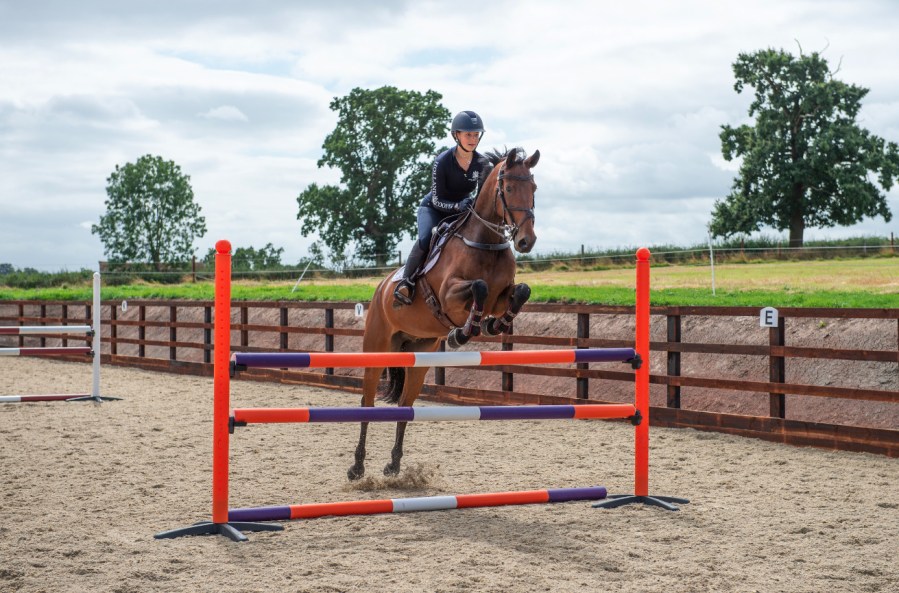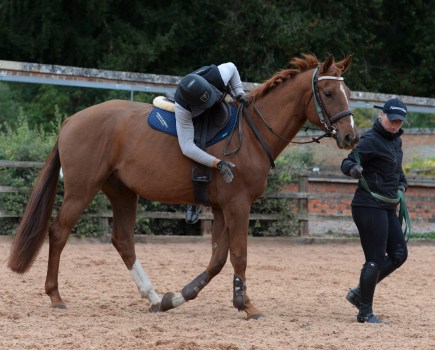When you find your horse losing impulsion, it can be useful to take them back to basics. This starts by working on the canter – finding something with lift rather than length. Cavaletti are the perfect tool to help with this, and so the majority of the following exercises focus on using these little fences to obtain the perfect canter for jumping. They also work those all-important turns that can make or break the approach to a fence. International showjumper Holly Smith shares four exercises to get you ready to jump clear around a course.
First, get your horse warmed up and listening to you. Start by riding some transitions and a serpentine across the arena.
“Push your horse ‘up’ into transitions,” says Holly. “Make sure that your transitions are off the leg – you put your leg on and, bam, you get a reaction.”
This sharp reaction is essential when jumping a course of obstacles.
Exercise 1: Kick start with polework
This is a great way to ease your horse into a training session.
“Placing your horse correctly at the first pole will help them to perform well through this,” says Holly.
Set it up: Place three poles two or three strides apart on the long side of the arena.
Draw a rectangle inside the arena in your head, from one three-quarter line to the other, with the triple of poles along one of the long sides of the rectangle. Planning the route in your head will help you place your horse correctly throughout.
How to ride it:
- Start on whichever rein you prefer. Go large in trot.
- As you use your legs, think of wrapping them around rather than drawing them up – it’s more effective and better for your seat.
- Look to the poles well before your turn, and aim for the centre of the first pole.
- Use your horse’s outside shoulder to keep their shoulders in line with no drifting.
- Give extra range and scope with your reins – let them stretch their back properly.
- You should be able to feel your horse really moving.
- Just before you hit the track, bend your horse around your inside leg. Create the corner, then trot along the empty side of your rectangle before another turn into the set of poles.
- Ride through the line of poles a couple of times on each rein until your horse feels more responsive and is picking up their feet well.
The next step: This exercise is great for riding transitions.
“Transitions make horses,” adds Holly. “If you get these foundations right, you’ll create a more fluid and supple horse.”
You could ask for canter along the long side, or hone your halts. Keep it interesting for your horse; if they start to get bored, throw something in they aren’t expecting.
Exercise 2: Cavaletti then turn
Some horses get excited before a jump, only to lose their momentum once they’ve over it. This exercise ensures that your horse is alert and listening after an obstacle, plus it continues working on their suppleness and bend.
It’s most effective when performed in canter as you can practise making sure your horse lands on the correct leg.
“These exercises are so simple,” says Holly. “Here you only need one cavaletti, but these ‘smaller’ exercises are great for your horse’s core.”
As before, make sure you don’t let your horse drift out on the corners.
“Drifting messes up stride counts, so it’s important to be straight and stay straight,” reminds Holly.
Set it up: Place a single cavaletti on the centre line in the middle of your arena.
How to ride it:
- Go large in canter – you want a bouncy canter, as there’s power in this kind of canter.
- Look early before you turn to approach the cavaletti.
- Once you’ve lined yourself up to the centre of the jump, don’t look down at the pole, look past it.
- Making sure that your eyes are looking up early will help you to look for the turn.
- After you’ve jumped the cavaletti, turn left or right. Alternate this and mix it up a bit. Focus on steering your horse’s outside shoulder.
- Often when you land on the wrong leg it’s because you’re losing that outside shoulder.
Exercise 3: Cavaletti bounce
Building on the previous exercise, it’s time to add a bounce.
Set it up: Make the single cavaletti into a bounce by adding another raised pole.
“Remember to move your eyes to the direction in which you want to head – this will help you to get the correct lead on landing,” says Holly.
How to ride it:
- The approach is the same as before – you’ve just got a bounce to get over before the turn.
- Decide early on which direction you want to turn after the cavaletti.
- It doesn’t matter if your horse gets the wrong lead. Try the bounce again and concentrate on giving them clear aids so that they know to prepare for the turn.
Exercise 4: Upright
Now you’ve worked on your bends and getting your horse active it’s time to hone that straightness over jumps.
Set it up: Change the cavaletti into an upright set at a height that you’re comfortable with.
“Make sure they take off dead straight,” says Holly. “Putting a channel of poles on the landing side can help you to check this.”
How to ride it:
- Go large in canter before looking for the jump.
- Think about the ideal take-off spot and make your canter fit that spot.
- Now look for the landing, keeping your outside leg on.
- Keep your weight to your outside stirrup.
- Look to turn tighter after the jump. This is not about pulling your horse around, it’s about supporting them.
- Repeat on the opposite rein.
Meet the expert: Holly Smith is an international showjumper. She was part of Great Britain’s showjumping team at the 2018 World Equestrian Games and won team bronze at the European Championships in 2019. The was part of the Great British showjumping team at the 2020 Tokyo Olympics where the team came 10th.
Lead image credit: Sally Newcomb/Kelsey Media Ltd
Check out our subscription offer









